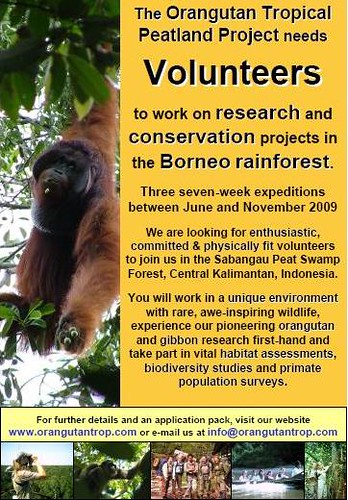
The Orangutan Tropical Peatland Research Project works to protect one of the most important areas of tropical rainforest in Borneo - the Sabangau Forest in Central Kalimantan, Indonesia. We monitor the distribution, population status, behaviour and ecology of the forest's flagship ape species – the orang-utan and agile gibbon - carry out biodiversity and forestry research, provide scientific feedback to conservation managers, and work with our local partners to implement successful conservation programmes. Our earliest work identified the Sabangau forest as home to the largest orang-utan population remaining in Borneo – 12% of the total world population - thus bringing the region to the forefront of orangutan conservation efforts. This resulted in the forest becoming a National Park in 2004. We work in partnership with Indonesian NGO the Centre for International Cooperation for Management of Tropical Peatland (CIMTROP) based at the University of Palangka Raya, Indonesia. Through this partnership we support local conservation efforts by implementing or funding a number of community-led conservation activities, including a Forest Patrol Unit, Fire-fighting Team, and programmes of environmental education, developing local livelihoods and habitat restoration. Through these programmes we have succeeded in stopping illegal logging in 2005 and damming illegal logging extraction canals and drainage channels. Our research and volunteer program has been running since 2001 and is a focus for local conservation efforts, providing much-needed employment and financial benefits for the local community and replacing illegal logging as the main activity and source of income in the northern Sabangau Forest.
Why we need you.
We need volunteers to help collect vital research data for conservation. We have an ongoing program of research in which we monitor orangutan and gibbon density; forest biodiversity; and habitat structure, productivity, regeneration and disturbance. We have a number of monitoring stations in the jungle at which we collect these data annually, in order to assess trends in the condition of the forest and its wildlife. This is a large amount of data and we couldn’t collect it all without the involvement of volunteer researchers. We use these results to provide feedback on the state of the habitat, report on problems and assess the effectiveness or otherwise of conservation programs. We need intelligent, fit, enthusiastic individuals to join our team and help us collect these vital data. We offer a challenging seven week program of field research with opportunities to carry out your own research project, together with visits to the Nyaru Menteng Orangutan Rehabilitation Project and Tanjung Puting National Park. We provide you with training in field methods, a window into a career as a conservation biologist and, hopefully, an unforgettable experience!
Where we work
The Sabangau River is a minor blackwater river in southern Borneo, in the Indonesian province of Central Kalimantan. The Sabangau forest covers an area of some 580,000 hectares of peat-swamp forest, the largest single area of lowland rainforest remaining in Kalimantan. Peat-swamp forest is a little-known, relatively inaccessible habitat, yet remarkably diverse and home to over 30% of the remaining population of wild orang-utans in Borneo. Peat formed here under waterlogged conditions through the incomplete breakdown of organic matter – dead leaves, branches and trees – and this has built up over many thousands of years to form a thick peat layer up to 18m deep in places. Standing atop the peat is a rich tropical rainforest, with a huge diversity of plant life, including large timber trees such as ramin and swamp meranti, a wide variety of pitcher plants and sustainable commercial species such as rattan and rubber trees. Nine species of primate including the orang-utan, agile gibbon, slow loris and pig-tailed macaque are found here; other notable animal life includes the sun-bear, bearded pig, clouded leopard, sambar deer, civets, treeshrews, water monitors, pythons, over 200 species of bird including the rhinoceros hornbill, Asian paradise flycatcher, Wallace’s hawk eagle and the endemic Bornean bristlehead; and a large and diverse invertebrate community. Our base camp is the Setia Alam Field Station, sited just inside the edge of the forest approximately 1 hour by car, boat and small train from the provincial capital of Palangka Raya. Facilities here are comfortable, including accommodation in purpose-built huts, washing and toilet facilities, office and laboratory, kitchen, drinking water, generator, radio, security guard and cook. We have a network of trails and permanent study plots inside the forest, and also carry out research at a number of satellite camps in the heart of the jungle. We have built basic huts at each of these sites and camp out here for up to a week at a time.
What you will do
We run three expeditions of seven weeks between mid-June and mid-November. This is the dry season and the best time for carrying out research – although tropical downpours still occur from time-to-time. We require volunteers to assist on most parts of the project, for a minimum period of seven weeks with us. The team will initially work from base camp, beginning the research whilst acclimatising to the conditions and receiving training on the research methods. Later on we will visit some of the remote field stations where we will camp in basic huts, sleeping under canvas, washing in the river and working during the day.
We have three main areas of research: 1) Monitoring habitat condition and status of biodiversity. For this we survey orangutans by counting their nests; gibbons by triangulating their morning calls and carry out line transect surveys of other primate species. We survey butterfly and bird diversity and density in areas of differing logging disturbance. We measure trees in permanent habitat plots to monitor changes in forest structure at each of our monitoring stations. 2) Assessing long-term regeneration, succession, and productivity processes in forest subject to different disturbances including selective logging, fire, natural gaps and canal construction. We have a large number of plots in which we measure elements of tree size, health and productivity and seedling and sapling density, growth and survival. 3) Studies of orang-utan and gibbon behavioural ecology. We follow habituated individuals of both species in order to better understand their behaviour, social interactions, food competition and ability to live in a disturbed forest. Although this does not form part of the behaviour program we do offer the opportunity to spend a day or two following both orangutans and gibbons with our behaviour research team, circumstances permitting. Conditions can be harsh in peat swamp forest – it is typically hot and humid, with difficult terrain. It is therefore extremely important that all members of the team are physically and mentally fit. Each research project will be coordinated by a separate OuTrop staff leader, who will provide full training for members of his/her team. Volunteers will get the opportunity to spend on each of the projects running during the season. The success of the expedition relies on all members of the team helping out in all aspects of the project, from carrying out research to maintaining transects, from shopping for supplies in Palangka Raya to collecting and purifying water at remote field sites. In addition to the research work, visits will be organised to the nearby Nyaru Menteng Orang-utan Reintroduction Centre, where we will see orphaned orangutans being trained for re-release into the forest, and older orangutans already released onto the beautiful Pulau Kaja island. There may also be an opportunity to visit the Kalaweit gibbon rehabilitation project. A four-day trip to the scenic and diverse Tanjung Puting National Park at the end of the project is arranged. Here you will see proboscis monkeys and longtailed macaques along the banks of the Sekonyer River, and visit Camp Leakey, the site of the first permanent orang-utan research project in Kalimantan and home to many adult orang-utans successfully reintroduced into the forest.
For more information and an application pack please visit the Orang-utan Tropical Peatland Project website.
